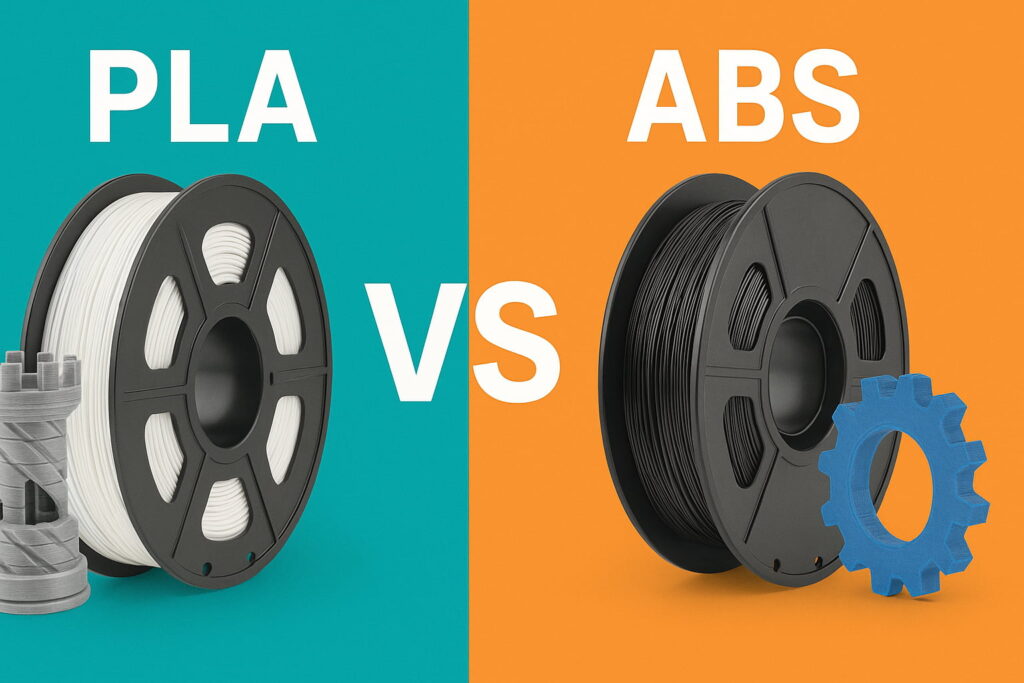
- +91 8055996347
- info@3dreality.in
- Chapru nagar square, CA road, Nagpur, Maharashtra-440008

3D printing has revolutionized the way we bring ideas to life — from quick prototypes to complex functional parts, the possibilities are endless. However, one of the most important decisions you’ll face before starting any 3D print is choosing the right material. Your choice can greatly impact the strength, flexibility, finish, and durability of your final product.
Two of the most popular and widely used materials in 3D printing are PLA (Polylactic Acid) and ABS (Acrylonitrile Butadiene Styrene). While both filaments have earned their place in the 3D printing world, they each offer distinct advantages and challenges. Understanding the differences between PLA and ABS is crucial — whether you’re a hobbyist printing decorative models, a student working on a project, or a business creating functional prototypes.
In this guide, we’ll take a closer look at PLA vs ABS — comparing their properties, uses, pros, and cons — to help you choose the best filament for your next 3D printing project.
PLA (Polylactic Acid) is a biodegradable thermoplastic derived from renewable resources like corn starch and sugarcane. It’s often the first choice for beginners because of its easy printability and smooth finish.
3D art and sculptures
Mild, pleasant smell during printing
Limited flexibility for functional parts
ABS (Acrylonitrile Butadiene Styrene) is an industrial-grade thermoplastic commonly used in automotive parts, electronic housings, and toys like LEGO bricks. It is favored for its durability and resistance to impact and heat.
Industrial equipment covers
Supports post-processing (sanding, painting, acetone smoothing)
Slightly rougher surface finish compared to PLA
| Feature | PLA (Polylactic Acid) | ABS (Acrylonitrile Butadiene Styrene) |
|---|---|---|
| Material Base | Biodegradable (corn starch, sugarcane) | Petroleum-based (non-biodegradable) |
| Ease of Printing | Very easy (great for beginners) | More challenging (needs controlled environment) |
| Print Temperature | 180-220°C | 220-250°C |
| Bed Temperature | 20-60°C (optional heated bed) | 80-110°C (heated bed required) |
| Warping | Low | High |
| Strength | Moderate (brittle under stress) | High (durable and tough) |
| Heat Resistance | Low (softens around 60°C) | High (withstands up to ~100°C) |
| Surface Finish | Glossy and smooth | Matte and slightly rough |
| Post-Processing | Limited (light sanding/painting) | Excellent (acetone smoothing, sanding, painting) |
| Fumes During Print | Minimal (mild smell) | Strong (requires ventilation) |
| Environmental | Eco-friendly | Less eco-friendly |
| Common Uses | Toys, models, prototypes, decorations | Functional parts, automotive, enclosures, tools |
When choosing between PLA and ABS, consider your project’s purpose, your printing setup, and your post-processing needs:
Choose PLA if:
Eco-friendliness matters to you.
Choose ABS if:
You plan to post-process (sanding, painting, or acetone smoothing).
Both PLA and ABS are excellent 3D printing materials, but they shine in different areas. If you’re after ease of use and an eco-friendly option for decorative prints, PLA is your go-to choice. On the other hand, if your project demands durability, strength, and resistance to heat, ABS is the winner.
By understanding their differences, you can make informed decisions and get the best results from your 3D printing journey.
Looking for ABS 3D printing services in Nagpur? At 3D Reality, we specialize in delivering high-quality, durable parts using premium ABS filament. Whether you need strong prototypes, industrial components, automotive parts, or functional tools, our ABS 3D printing solutions are designed to meet your toughest requirements.
ABS is known for its excellent strength, impact resistance, and heat tolerance — making it ideal for businesses and engineers in Nagpur who need reliable, long-lasting parts. With our advanced 3D printers and expert team, we ensure precise prints with minimal warping and professional post-processing options like acetone smoothing and painting.
Local support at our Nagpur center
Whether you’re an automotive manufacturer, product designer, or a startup building prototypes, 3D Reality is your trusted partner for ABS 3D printing in Nagpur.
👉 Contact us today at +91 9405811166 or visit our studio at Madhav Tower, Chapru Nagar Square, CA Road, Nagpur to discuss your project!
Q1) Is PLA stronger than ABS?
ABS is generally stronger and more impact-resistant, while PLA is stiffer but tends to be more brittle.Q2) Can I print ABS without an enclosure?
You can try, but ABS is prone to warping and cracking without an enclosed printer. Q3) Is PLA eco-friendly?
Yes, PLA is made from renewable resources and is biodegradable under industrial composting conditions. Q4) Does ABS require acetone smoothing?
Not required, but acetone smoothing can significantly improve the surface finish of ABS prints.